Toe Adjustments
Toe is expressed in either degrees or fraction of an inch.
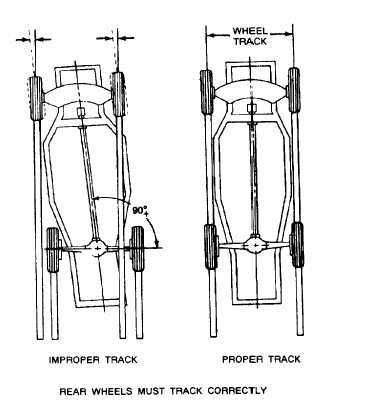 The toe angle identifies the exact direction the tires are pointed relative to the centerline of the car when viewed from above. Straight toe keeps the wheels pointed straight, when pointed slightly toward each other would be toe-in while away from each other would be toe-out. Performance rides are normally set with a small amount of toe out. This provides directional stability and is typically used to help compensate for the suspension bushings compliance to enhance tire life. Any casual bump on the pavement ,accident or changes in the ride height may change the toe setting.
The toe angle identifies the exact direction the tires are pointed relative to the centerline of the car when viewed from above. Straight toe keeps the wheels pointed straight, when pointed slightly toward each other would be toe-in while away from each other would be toe-out. Performance rides are normally set with a small amount of toe out. This provides directional stability and is typically used to help compensate for the suspension bushings compliance to enhance tire life. Any casual bump on the pavement ,accident or changes in the ride height may change the toe setting.Front wheel drive vehicles requires instead some negative toe out while rear wheel vehicles requires some positive toe in to enable the tires to run parallel to each other at speed. Besides that, Toe can also be used to adjust the car handling characteristics. Increased toe in will typically result in reduced over-steer, help steady the car and enhance high speed stability. While increase toe out will typically result in reduced under steer, helping free up the car especially during initial turin in while entering a corner.

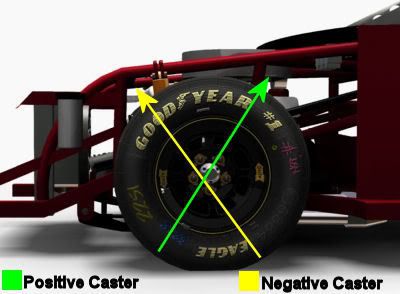 Caster is expressed in degrees. This positions the wheel forward or rearward when viewed directly from the side of the car. Positive caster, positions the wheel closer to the front bumper, and negative caster, positions the wheel toward the rear of the fender. Increasing the amount of positive caster will increase steering effort and straight line tracking, as well as improve high speed stability and cornering effectiveness. Positive caster, as with most performance cars also increases tire lean when cornering as the steering angle is increased.
Caster is expressed in degrees. This positions the wheel forward or rearward when viewed directly from the side of the car. Positive caster, positions the wheel closer to the front bumper, and negative caster, positions the wheel toward the rear of the fender. Increasing the amount of positive caster will increase steering effort and straight line tracking, as well as improve high speed stability and cornering effectiveness. Positive caster, as with most performance cars also increases tire lean when cornering as the steering angle is increased.Camber Adjustment
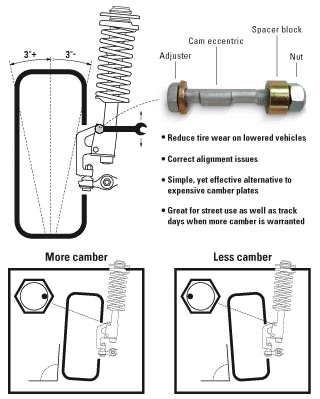
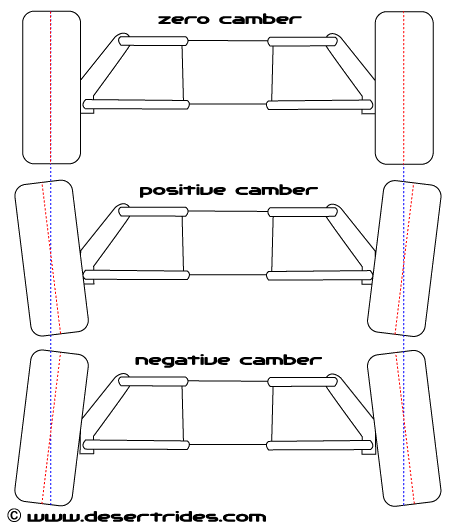 Camber is expressed in degrees. Camber alter the angle of the wheel relative to vertical. If the wheel slants in towards the chassis, it has negative camber. If it slants away from the car, it has positive camber. Normally a lowered vehicle will exhibit a certain amount of negative camber. Camber Bolt on wheel kits allow to reset the camber angles to its optimum settings. However rear camber adjustability is not critical on most FWD vehicles. To have a better cornering grip and longer tire life it is prefer to have more negative camber. However there are some drawbacks which are having floaty feeling when braki
Camber is expressed in degrees. Camber alter the angle of the wheel relative to vertical. If the wheel slants in towards the chassis, it has negative camber. If it slants away from the car, it has positive camber. Normally a lowered vehicle will exhibit a certain amount of negative camber. Camber Bolt on wheel kits allow to reset the camber angles to its optimum settings. However rear camber adjustability is not critical on most FWD vehicles. To have a better cornering grip and longer tire life it is prefer to have more negative camber. However there are some drawbacks which are having floaty feeling when braki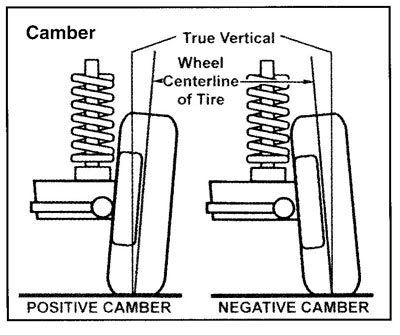 ng since the tires are not flat on the ground and the inside edges of the tires will end up wearing faster than the outside edge. The trick is to use enough negative camber to provide good cornering performance while not requiring the tire to put too muc of its load on the inner edge while traveling in a straight line.
ng since the tires are not flat on the ground and the inside edges of the tires will end up wearing faster than the outside edge. The trick is to use enough negative camber to provide good cornering performance while not requiring the tire to put too muc of its load on the inner edge while traveling in a straight line.











No comments:
Post a Comment